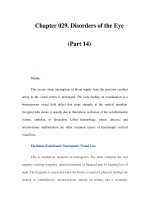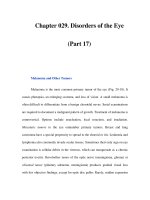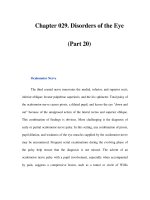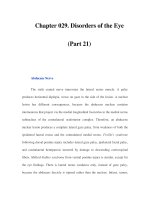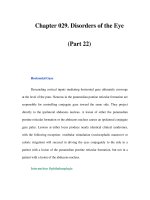Chapter 029. Disorders of the Eye (Part 17) potx
Bạn đang xem bản rút gọn của tài liệu. Xem và tải ngay bản đầy đủ của tài liệu tại đây (31.74 KB, 5 trang )
Chapter 029. Disorders of the Eye
(Part 17)
Melanoma and Other Tumors
Melanoma is the most common primary tumor of the eye (Fig. 29-18). It
causes photopsia, an enlarging scotoma, and loss of vision. A small melanoma is
often difficult to differentiate from a benign choroidal nevus. Serial examinations
are required to document a malignant pattern of growth. Treatment of melanoma is
controversial. Options include enucleation, local resection, and irradiation.
Metastatic tumors to the eye outnumber primary tumors. Breast and lung
carcinoma have a special propensity to spread to the choroid or iris. Leukemia and
lymphoma also commonly invade ocular tissues. Sometimes their only sign on eye
examination is cellular debris in the vitreous, which can masquerade as a chronic
posterior uveitis. Retrobulbar tumor of the optic nerve (meningioma, glioma) or
chiasmal tumor (pituitary adenoma, meningioma) produces gradual visual loss
with few objective findings, except for optic disc pallor. Rarely, sudden expansion
of a pituitary adenoma from infarction and bleeding (pituitary apoplexy) causes
acute retrobulbar visual loss, with headache, nausea, and ocular motor nerve
palsies. In any patient with visual field loss or optic atrophy, CT or MR scanning
should be considered if the cause remains unknown after careful review of the
history and thorough examination of the eye.
Figure 29-18
Proptosis
When the globes appear asymmetric, the clinician must first decide which
eye is abnormal. Is one eye recessed within the orbit (enophthalmos) or is the
other eye protuberant (exophthalmos, or proptosis)? A small globe or a Horner's
syndrome can give the appearance of enophthalmos. True enophthalmos occurs
commonly after trauma, from atrophy of retrobulbar fat, or fracture of the orbital
floor. The position of the eyes within the orbits is measured using a Hertel
exophthalmometer, a hand-held instrument that records the position of the anterior
corneal surface relative to the lateral orbital rim.
If this instrument is not available, relative eye position can be judged by
bending the patient's head forward and looking down upon the orbits. A proptosis
of only 2 mm in one eye is detectable from this perspective. The development of
proptosis implies a space-occupying lesion in the orbit, and usually warrants CT or
MR imaging.
Graves' Ophthalmopathy
This is the leading cause of proptosis in adults (Chap. 335). The proptosis is
often asymmetric and can even appear to be unilateral. Orbital inflammation and
engorgement of the extraocular muscles, particularly the medial rectus and the
inferior rectus, account for the protrusion of the globe.
Corneal exposure, lid retraction, conjunctival injection, restriction of gaze,
diplopia, and visual loss from optic nerve compression are cardinal symptoms.
Graves' ophthalmopathy is treated with oral prednisone (60 mg/d) for 1 month,
followed by a taper over several months, topical lubricants, eyelid surgery, eye
muscle surgery, or orbital decompression. Radiation therapy is not effective.
Orbital Pseudotumor
This is an idiopathic, inflammatory orbital syndrome, frequently confused
with Graves' ophthalmopathy. Symptoms are pain, limited eye movements,
proptosis, and congestion.
Evaluation for sarcoidosis, Wegener's granulomatosis, and other types of
orbital vasculitis or collagen-vascular disease is negative. Imaging often shows
swollen eye muscles (orbital myositis) with enlarged tendons. By contrast, in
Graves' ophthalmopathy the tendons of the eye muscles are usually spared.
The Tolosa-Hunt syndrome may be regarded as an extension of orbital
pseudotumor through the superior orbital fissure into the cavernous sinus. The
diagnosis of orbital pseudotumor is difficult. Biopsy of the orbit frequently yields
nonspecific evidence of fat infiltration by lymphocytes, plasma cells, and
eosinophils. A dramatic response to a therapeutic trial of systemic glucocorticoids
indirectly provides the best confirmation of the diagnosis.

